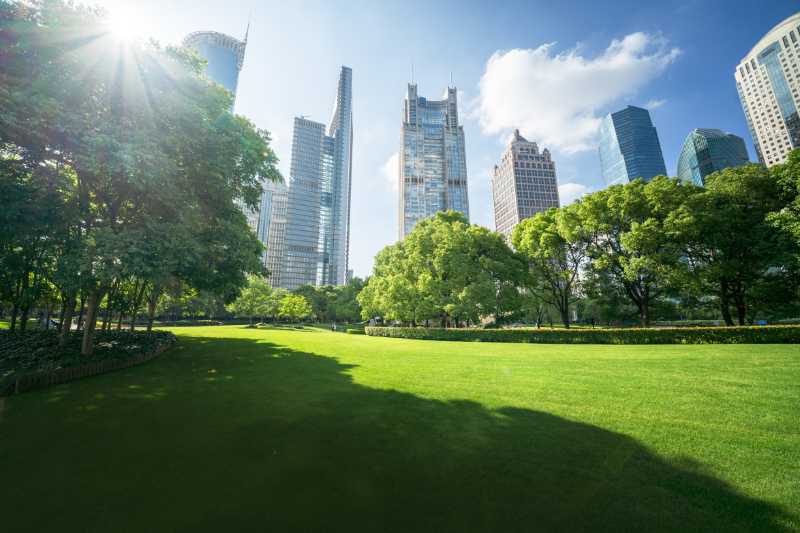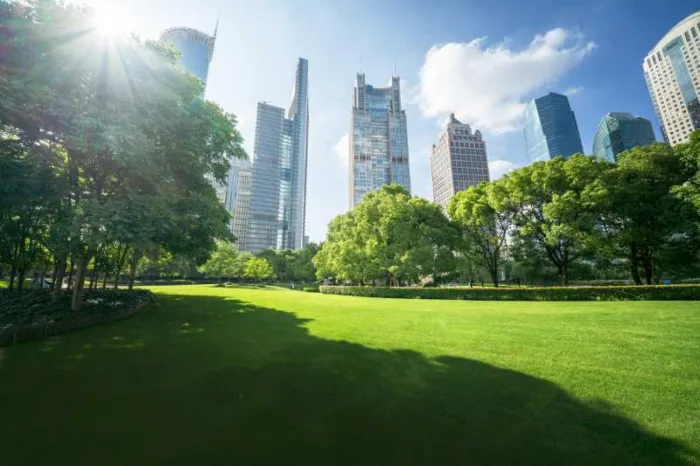Key takeaways
- A greener community is designed to be sustainable, reducing its impact on the environment while also opposing income inequality and social injustice.
- Sustainable communities are important because they help prevent climate change and address social issues.
- Some qualities of a green community include smart urban planning, resource conservation, and alternative transportation options.
- Starting a garden, getting political, and joining environmental organizations are just a few ways of starting a sustainable community.

Urbanization is a major contributor to climate change and continues to grow as the population increases. So, embracing greener communities and sustainable buildings are some effective tactics for reducing the effects of global warming.
With that said, it’s best if you learn what greener communities are, what advantages they offer, and their qualities. More importantly, you’ll discover how to transform your community into a greener and more sustainable society.
This post covers:
- What is a greener community?
- Why is it important to have a sustainable community?
- Qualities of sustainable communities
- How can we make our community greener?
What is a greener community?
Greener communities, also known as sustainable communities, are neighborhoods that aim to reduce their impact on the environment by implementing eco-friendly practices.
Additionally, sustainable communities strive to fight income inequality and social injustice, as these threaten the livelihoods of society members.
Green communities may be planned and built with sustainability in mind, whereas a majority are modified to meet such values. Regardless of how they’re developed, greener communities offer significant advantages for their members and the environment as a whole.
Green community examples
There are many examples of green communities, but one of the most well-known is Dancing Rabbit Ecovillage.
Dancing Rabbit is a 280-acre community located in Rutledge, Missouri. Established in 1997, Dancing Rabbit has a population of about 30 people who follow sustainable community guidelines.
While all of Dancing Rabbit’s community members abide by certain guidelines, everyone is responsible for their own income, housing, food, and other needs.
Why is it important to have a sustainable community?
With 80% of Americans living in cities and towns, the growth of urban environments is expected to boom in the years ahead. As a result, escalating urbanization will influence many social issues, such as the climate, social equality, and wealth distribution.
Through the widespread adoption of sustainable practices within urban areas, communities can cultivate a higher quality of life for their residents. For instance, the incorporation of green spaces like parks or gardens serves as a way to promote exercise, facilitate access to fresh air, foster socialization, and encourage outdoor hobbies.
Meanwhile, sustainability efforts, such as renewable energy and resource conservation, play a major role in combating the ever-growing threat of climate change. Without the broad implementation of such measures, the consequences we’ll experience include severe weather changes, higher water levels, and fewer natural resources.
Above all, the establishment of a greener community goes beyond simply local issues but rather encompasses a global affair. Green living not only makes life more enjoyable but also ensures the viability of our planet.
Learn what sustainable building is and how it’s implemented:
What are the advantages of a green community?
A greener community offers the following advantages:
- Energy efficiency. Incorporating renewable energy sources, such as solar, wind, and hydropower, reduces the consumption of harmful fossil fuels. These energy sources are clean and inexhaustible, making them much more efficient than traditional options.
- Job creation. Developing a green community requires significant labor, which paves the way for a slew of new job opportunities. Plus, these communities need to be built, monitored, maintained, and improved.
- Long-term savings. Investing in a greener community requires substantial capital initially. However, you can expect long-term savings from lower maintenance costs, energy efficiency, and other sustainability efforts.
- Community engagement. Incorporating sustainable programs and efforts within a community encourages engagement amongst members because of comradery. People want to feel pride when they’re involved with a positive movement like a greener community.
- Reduced carbon emissions. Taking advantage of renewable energy and integrating sustainable practices to decarbonize buildings will pave the way for fewer carbon emissions, a driver in climate change.
- Resilience to climate change. Adopting sustainable practices in your community will better prepare you for the effects of climate change. For example, design infrastructure and real estate to withstand extreme weather conditions. If these structures can adapt to the elements, your community will be better off.
Qualities of sustainable communities
To be considered a greener community, you often must have certain qualities or features.
Sustainable community qualities include:
- Smart urban planning
- Transportation alternatives
- Resource conservation
- Economic vitality
- Social equity and inclusion
Smart urban planning
In many cases, urban areas are wrought with poor planning and design, creating a number of problems. Conversely, sustainable communities take different approaches by incorporating compact and mixed-use developments to reduce urban sprawl. In turn, cities are walkable and have less of an impact on the environment.
Additionally, smart urban planning includes the inclusion of green spaces, which are essential in densely populated areas. Green spaces provide cleaner air, a place to participate in outdoor activities, and promote exercise.
Green spaces take many different forms, such as:
- Parks
- Green roofs
- Community gardens
- Landscaping
- Street trees
- Wetlands
- Ponds and lakes
Transportation alternatives
Similarly to urban planning, transportation is a vital aspect of a green community. By developing real estate densely and using mixed-use buildings, people can walk to the places they want. In addition, such infrastructure paves the way for safer environments for those who enjoy walking and biking.
Of course, public transportation is a must for sustainable communities because it helps reduce carbon emissions. Buses, trains, and bike-sharing services are effective solutions for reducing individual car usage. As an added benefit, municipalities garner revenue from public transit programs.

Resource conservation
Cities are known for their extreme waste, which is why greener communities are overhauling the consumption of resources and waste management. Green communities take advantage of solar, wind, and other renewable energy sources, helping them reduce waste. Building green real estate also helps reduce the use of energy by taking advantage of new technologies and natural processes.
Simultaneously, water usage is lowered by collecting rainwater and installing efficient irrigation systems. Recycling programs and effectively using resources to get the most out of them help lower waste even further.
Economic vitality
In order to develop a strong and sustainable economy, it’s vital to support local businesses so that cities and towns can rely less on external resources. Moreover, local businesses bring much-needed jobs to the community, which enhances the economy.
Other ways to stimulate the local economy include:
- Encouraging the creation of farmer’s markets
- Investing in community initiatives
- Promoting responsible tourism practices (if applicable)
- Researching and developing sustainable practices
- Promoting the development of green jobs
- Invest in initiatives to assist with developing new skills and managing finances
Social equity and inclusion
For a community to sustain itself, its members must have adequate and equal access to housing, healthcare, transportation, jobs, and more. Otherwise, the community is unable to sustain itself.
Fortunately, there are many methods of implementing social equity and inclusion:
- Build diverse housing options for various income levels
- Pass inclusive zoning policies
- Build healthcare facilities or partner with them to distribute services
- Develop inclusive educational institutions and programs
- Seek input from the community regarding decision-making
- Implement laws that prohibit discrimination
- Ensure public spaces and buildings are easily accessible to anyone
- Make public transportation affordable and widely accessible
- Develop community support programs for those vulnerable populations
- Ensuring the safety of your tenants with appropriate access control measures
How can we make our community greener?
If you’re looking to improve the sustainability of your community, there are several actions you can take to help.
Here are some greener community ideas you can start today:
- Start a garden. Plant native species on your property or advocate to start a community garden in your neighborhood. Regardless, doing so will benefit the local wildlife and let you enjoy your own homegrown food.
- Take alternative transportation. Consider taking the bus or train to work instead of your car to reduce carbon emissions. If these transit options are not available, ask your coworkers if they’d like to start apartment car sharing. Otherwise, look into getting an electric vehicle to reduce your carbon footprint.
- Join local environmental organizations. Research local organizations to join regarding environmental conservation. You’ll have the opportunity to connect with like-minded people in your area while also getting the chance to volunteer in various initiatives.
- Spread the word in your community. If your community doesn’t have a local organization, reach out to your neighbors to tell them about your own goals when it comes to sustainability. Chances are, you’ll find individuals who believe in your goals and will want to pitch in any way they can. Nonetheless, it’s always important to get the word out about green communities as it will naturally attract others with similar aspirations.
- Get political. Lastly, it’s vital you voice your opinion on environmental, social, and economic policies being discussed. Reach out to your state representatives to voice your opinion on policies, volunteer for a representative’s campaign, and, more importantly, go vote. Doing so will allow you to express your opinions regarding essential policies regarding sustainability.







